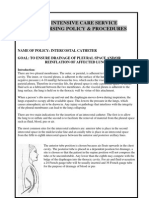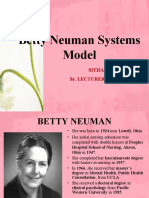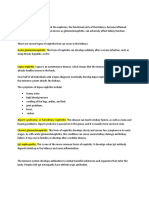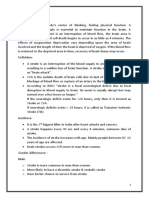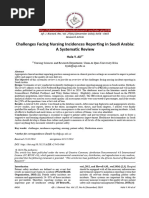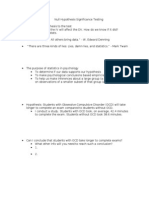Sampling 2
Uploaded by
halayehiahSampling 2
Uploaded by
halayehiahDefinition
Probability Sampling involves the use of a random selection process to select a sample from elements of a population.
Characteristics It gives all the individuals in the population equal chances of being selected. The goal is to examine representative elements of populations. There are five types of probability sampling 1. Simple random sampling 2. Stratified random sampling 3. Systematic random sampling 4. Cluster/multistage sampling 1- Simple random sampling Definition It is a type of probability sampling that ensures each element of the population has an equal and independent chance of being chosen. Prerequisites Population must be homogeneous. Researcher must have list of the elements. Methods The lottery method The use of table of random numbers The use of computer The lottery methods Each member of the population is assigned a unique number. Each number is placed in a bowl or a hat and mixed thoroughly . The blind folded researcher then picks numbered tags from the hat.
All the individuals bearing the numbers picked by the researcher are the subjects for the study. The use of table of random numbers Example selecting a sample of 15 from a population of 80 Assign a number to each element of the accessible population Enter the table of random numbers at an arbitrary or random starting point. You might close your eyes and blindly point to a number in the table. Suppose you choose number 58. Continue in a systematic way either up, down, to the left, right, or diagonally. The direction is not important, but make the decision before You start the process, and continue this direction until the total samples is selected. Continue to select numbers until you select 15 numbers. The number are circle in table. If you encounter a number more than once, skip it. The use of computer Nowadays random tables may be generated from the computer and subjects may be selected as described in the used of random table.
Simple random sampling Advantages Most reliable and unbiased method. Require minimum knowledge of study population. Free from sampling errors/bias.
Disadvantage Needs up to date complete list of all the members of the population. Expensive and time consuming. 2- Stratified random sampling A probability sampling procedure that is a variation of simple random sampling. This method is used for heterogeneous population. The populations divided into homogenous subgroups or strata according to some variable or variables of importance to the research study. Variables commonly used for stratification include age, gender, ethnicity, socioeconomic status, diagnosis, geographic region, type of care etc. After dividing the population into subgroup the researcher decides how large a sample is required from each subgroup. Two types of approaches may be used. Proportional stratified sampling or disproportional sampling . 1- Proportionate stratified random sampling In this the sample chosen from each stratum is in, proportion to the size of the total population. This means that the each stratum has the same sampling fraction. Stratum Population size Sampling fraction Final sample size A 100 1/2 50 B 200 1/2 100 C 300 1/2 150 stratified
2- Disproportionate stratified random sampling In this subtype the sample chosen from each stratum are not in proportion to size of total population in that stratum. With disproportionate sampling, the different strata have different sampling fraction. Stratum Population size Sampling fraction Final sample size Advantages Ensures representative sample in heterogeneous population. Comparison is possible in two groups. Disadvantages Requires complete information of population. Large population is required. Chances of faulty classification of strata. 3- Cluster sampling: multistage sampling Definition A form of sampling in which large groupings[ clusters] are selected first [e,g, nursing schools], with successive sub sampling of smaller units [e.g nursing students]. A 100 1/2 50 B 200 1/4 50 C 300 1/6 50
Prerequisite A sampling frame is developed that includes the list of states, cities, institutions or organizations with which the elements of the identified population would be linked. The cluster can be selected by simple or stratified methods. Because the sample is selected from cluster in two or more separate stages, the approach is sometimes called multistage sampling. Advantages Cheap, quick, and easy for a large population Saves time and money. Arrangements made with small no. of sampling units. Characteristics of clusters as well as those of population can be estimated. Disadvantages Larger sampling errors than other probability samples. Requires assignment of each member of population uniquely to a cluster. Statistics are more complicated. 4- Systematic random sampling Systematic Random sampling is done when an ordered list of all population is available. The process involves selecting every kth element of the population, such as every fifth, tenth etc. First decide the no of Population(N), then sample size(n). Sampling interval width (k) is determined by N/n. E g . In a population of 500 for a sample of 50,the sampling interval would be k= 500/ 50= 10.
Criteria a) The sampling frame must be random with respect to the variable of interest and , b) The first element or member of the sample must be selected randomly. [ table of random number] . If not the sample becomes a non-probability sample. Later every Kth subject is selected from sampling frame. Advantages Easy to draw sample Economical Time saving technique Disadvantages Samples may be biased if ordering of population is not random. After the 1st sampling element chosen, population members no longer have equal chances of being chosen . Non probability sampling technique Definition Non probability sampling is a technique wherein the samples are gathered in a process that does not give all the individuals in the population equal chances of being selected in the sample. In non-probability sampling the sample elements are chosen from the population by nonrandom methods. Not every element in the population has an opportunity for selection in sample. Types of non-probability sampling techniques 1234Convenience Sampling [ accidental or incidental] Snowball sampling [Network sampling] Quota sampling Purposive sampling [ judgmental /authoritative ]
1- Convenience sampling Definition Convenience sampling is a non-probability sampling technique wherein subjects are selected because of their convenient accessibility and proximity to the researcher. It involves choosing readily available subjects for a study. These elements may or may not be typical of the population.
May be unreliable. Advantages Inexpensive, accessible- saves time and money. Disadvantages Sampling bias. The sample is not representative of the entire population. Findings generated from these samples cannot be generated on the populations. 2- Snowball sampling Definition This term is used to describe a method of sampling that involves the assistance of study subjects to help obtain other potential subjects. Eg. Drug user, HIV/AIDS among commercial sex workers. It is also called chain referral sampling. Linear snowball sampling:- In this each selected sample is asked to provide reference of only one similar subject; where a linear chain is created by the completion of desired sample.
Exponential non discriminative snowball sampling In this each sample member is asked to provide reference of at least two similar subjects because of which the size of the sample size grows exponentially and a large sample size can be achieved.
Exponential discriminative snowball sampling In this initially one sample is selected and asked for two references of similar subjects, out of which at least one subjects must be active to provide further references and another could be non active In providing references. 3- Quota sampling Definition Quota sampling is a non probability sampling technique wherein the researcher ensures equal or proportionate representation of subjects, depending on which trait is considered as the basis of the quota . The basis of quota are usually age, gender, education, race, religion, and socioeconomic status. Quota sampling is similar to stratified sampling except nonrandom sampling method is used here. Divide the population into homogenous strata and selecting sample elements from each of these strata.
This is to include subject types that are underrepresented in the convenience sample. over convenient
Quota sampling represent an improvement sampling and tends to decrease potential biases. Advantage Economically cheap. Disadvantages Not possible to estimate errors
Bias is possible, as investigator/ interviewer can select persons known to him. 4- Purposive sampling Definition It is a non probability sampling technique wherein, subjects are chosen to be part of the sample with a specific purpose in mind. Involves handpicking of subjects. Subjects are chosen that the researcher believes are typical or representative , of the accessible population this is based on the assumption that the researcher has enough knowledge about the population. Advantages Simple to draw a sample. Saves resources as it requires less field work. Disadvantages Require considerable knowledge about the population. Conscious biases may occur.
You might also like
- Health Care Delivery Concerns, National Health and100% (1)Health Care Delivery Concerns, National Health and26 pages
- Step 4 - Build Reference and Counter-Reference Process - Group 151024 - 8No ratings yetStep 4 - Build Reference and Counter-Reference Process - Group 151024 - 815 pages
- ANP - Assignment Conceptual Models Final PDFNo ratings yetANP - Assignment Conceptual Models Final PDF26 pages
- Assessment Diagnoses: Planning Intervention Rationale EvaluationNo ratings yetAssessment Diagnoses: Planning Intervention Rationale Evaluation13 pages
- Revised National Tuberculosis Control ProgrammeNo ratings yetRevised National Tuberculosis Control Programme7 pages
- Control of Diarrhoeal Diseases, Acute Diarrhoeal DiseasesNo ratings yetControl of Diarrhoeal Diseases, Acute Diarrhoeal Diseases60 pages
- Revised National Tuberculosis Control Programme BY Hariom MehtaNo ratings yetRevised National Tuberculosis Control Programme BY Hariom Mehta25 pages
- Reference Writing Styles: Mrs. Monika Sharma Lecturer, DMCH, CON, Ludhiana. PunjabNo ratings yetReference Writing Styles: Mrs. Monika Sharma Lecturer, DMCH, CON, Ludhiana. Punjab82 pages
- What Is Peripheral Arterial Disease?: For More Information, VisitNo ratings yetWhat Is Peripheral Arterial Disease?: For More Information, Visit15 pages
- Rhemuatoid Arthritis: Post RN BSN 1 Semester JCON Pushpa Kumari Abdul Hafeez Raza Muhammad Ghulam Murtaza 20/11/2020No ratings yetRhemuatoid Arthritis: Post RN BSN 1 Semester JCON Pushpa Kumari Abdul Hafeez Raza Muhammad Ghulam Murtaza 20/11/202019 pages
- Presented By: Dr. Akhlas Ahmed Lecture # 08 Preston UniversityNo ratings yetPresented By: Dr. Akhlas Ahmed Lecture # 08 Preston University20 pages
- CM 2.5 Poverty & Social Security MeasuresNo ratings yetCM 2.5 Poverty & Social Security Measures45 pages
- Betty Neuman Systems Model: Sithara.S Sr. Lecturer, Mims ConNo ratings yetBetty Neuman Systems Model: Sithara.S Sr. Lecturer, Mims Con51 pages
- Nephritis: Alport Syndrome, or Hereditary NephritisNo ratings yetNephritis: Alport Syndrome, or Hereditary Nephritis3 pages
- History and Physical Assessment of Integumentary System: Mrs - Nilakshi Barik LecturerNo ratings yetHistory and Physical Assessment of Integumentary System: Mrs - Nilakshi Barik Lecturer84 pages
- IM Injuction: Definition of Intramuscular InjectionNo ratings yetIM Injuction: Definition of Intramuscular Injection8 pages
- Health Care Delivery System in India PDFNo ratings yetHealth Care Delivery System in India PDF29 pages
- Minorailments: Saddam Hussain Lecturer Winm, Bharuch100% (1)Minorailments: Saddam Hussain Lecturer Winm, Bharuch46 pages
- Nursing and Rehabilitation of Residents of Old Age HomeNo ratings yetNursing and Rehabilitation of Residents of Old Age Home40 pages
- RNTCP India - Training Module (Dec - 2010) For Medical Officers100% (1)RNTCP India - Training Module (Dec - 2010) For Medical Officers128 pages
- Pulmonary Arterial Hypertension in Congenital Heart Disease: Eisenmenger’s Syndrome - A Global PerspectiveFrom EverandPulmonary Arterial Hypertension in Congenital Heart Disease: Eisenmenger’s Syndrome - A Global PerspectiveNo ratings yet
- Impact of COVID19 on the Hygiene Practices of Adolescent inNo ratings yetImpact of COVID19 on the Hygiene Practices of Adolescent in12 pages
- Work Psychology Understanding Human BehaNo ratings yetWork Psychology Understanding Human Beha2 pages
- Role Transition Among Baccalaureate Nursing Students at Umm Al Qura UniversityNo ratings yetRole Transition Among Baccalaureate Nursing Students at Umm Al Qura University1 page
- Code of Ethics For Healthcare PractitionNo ratings yetCode of Ethics For Healthcare Practition60 pages
- Power, Politics and Delegation in Professional Nursing PracticeNo ratings yetPower, Politics and Delegation in Professional Nursing Practice28 pages
- 2nd Lecture Normal Phsiological Changes of Aging Final1.Ppt40-41No ratings yet2nd Lecture Normal Phsiological Changes of Aging Final1.Ppt40-4185 pages
- Results: Manal M. Ibrahim, Manal H. Abou Al-Magd, & Hala Y. SayedNo ratings yetResults: Manal M. Ibrahim, Manal H. Abou Al-Magd, & Hala Y. Sayed1 page
- Southeastern College of Padada, Inc. E-Class Record For CollegeNo ratings yetSoutheastern College of Padada, Inc. E-Class Record For College17 pages
- Answer On Question 39513 - Math - StatisticsNo ratings yetAnswer On Question 39513 - Math - Statistics1 page
- واقع ممارسات الإبداع التكنولوجي في المؤسسة الصناعية - دراسة ميدانية بمؤسسة كوندور إلكترونيكNo ratings yetواقع ممارسات الإبداع التكنولوجي في المؤسسة الصناعية - دراسة ميدانية بمؤسسة كوندور إلكترونيك20 pages
- cdn3.digialm.com__per_g28_pub_2083_touchstone_AssessmentQPHTMLMode1__2083O23354_2083O23354S14D12518_17068801273971449_AP18008125_2083O23354S14D12518E1.html#No ratings yetcdn3.digialm.com__per_g28_pub_2083_touchstone_AssessmentQPHTMLMode1__2083O23354_2083O23354S14D12518_17068801273971449_AP18008125_2083O23354S14D12518E1.html#35 pages
- An Experimental Analysis: The Effectiveness of Team Size On Managing Complex TaskNo ratings yetAn Experimental Analysis: The Effectiveness of Team Size On Managing Complex Task41 pages
- Test Theory: Categorize Tests According To Type of Behavior They MeasureNo ratings yetTest Theory: Categorize Tests According To Type of Behavior They Measure3 pages
- Qualitative Vs Quantitative Research - Examples & MethodsNo ratings yetQualitative Vs Quantitative Research - Examples & Methods9 pages
- Minitab Nonparametric Statistics Rank TestsNo ratings yetMinitab Nonparametric Statistics Rank Tests4 pages
- Pengaruh Daya Tarik Iklan, Atribut Produk, Dan Persepsi Harga Terhadap Keputusan Pembelian Pada Produk Minuman Rasa Jeruk Merek FloridinaNo ratings yetPengaruh Daya Tarik Iklan, Atribut Produk, Dan Persepsi Harga Terhadap Keputusan Pembelian Pada Produk Minuman Rasa Jeruk Merek Floridina9 pages
- Synthesising Qualitative and Quantitative Evidence A Review of Possible MethodsNo ratings yetSynthesising Qualitative and Quantitative Evidence A Review of Possible Methods11 pages
- 01 General Biology 1 Class Summary Template Per Subject Grade Level - Section - Subject - Quarter NoNo ratings yet01 General Biology 1 Class Summary Template Per Subject Grade Level - Section - Subject - Quarter No185 pages
- Health Care Delivery Concerns, National Health andHealth Care Delivery Concerns, National Health and
- Step 4 - Build Reference and Counter-Reference Process - Group 151024 - 8Step 4 - Build Reference and Counter-Reference Process - Group 151024 - 8
- Assessment Diagnoses: Planning Intervention Rationale EvaluationAssessment Diagnoses: Planning Intervention Rationale Evaluation
- Control of Diarrhoeal Diseases, Acute Diarrhoeal DiseasesControl of Diarrhoeal Diseases, Acute Diarrhoeal Diseases
- Revised National Tuberculosis Control Programme BY Hariom MehtaRevised National Tuberculosis Control Programme BY Hariom Mehta
- Reference Writing Styles: Mrs. Monika Sharma Lecturer, DMCH, CON, Ludhiana. PunjabReference Writing Styles: Mrs. Monika Sharma Lecturer, DMCH, CON, Ludhiana. Punjab
- What Is Peripheral Arterial Disease?: For More Information, VisitWhat Is Peripheral Arterial Disease?: For More Information, Visit
- Rhemuatoid Arthritis: Post RN BSN 1 Semester JCON Pushpa Kumari Abdul Hafeez Raza Muhammad Ghulam Murtaza 20/11/2020Rhemuatoid Arthritis: Post RN BSN 1 Semester JCON Pushpa Kumari Abdul Hafeez Raza Muhammad Ghulam Murtaza 20/11/2020
- Presented By: Dr. Akhlas Ahmed Lecture # 08 Preston UniversityPresented By: Dr. Akhlas Ahmed Lecture # 08 Preston University
- Betty Neuman Systems Model: Sithara.S Sr. Lecturer, Mims ConBetty Neuman Systems Model: Sithara.S Sr. Lecturer, Mims Con
- Nephritis: Alport Syndrome, or Hereditary NephritisNephritis: Alport Syndrome, or Hereditary Nephritis
- History and Physical Assessment of Integumentary System: Mrs - Nilakshi Barik LecturerHistory and Physical Assessment of Integumentary System: Mrs - Nilakshi Barik Lecturer
- IM Injuction: Definition of Intramuscular InjectionIM Injuction: Definition of Intramuscular Injection
- Minorailments: Saddam Hussain Lecturer Winm, BharuchMinorailments: Saddam Hussain Lecturer Winm, Bharuch
- Nursing and Rehabilitation of Residents of Old Age HomeNursing and Rehabilitation of Residents of Old Age Home
- RNTCP India - Training Module (Dec - 2010) For Medical OfficersRNTCP India - Training Module (Dec - 2010) For Medical Officers
- Pulmonary Arterial Hypertension in Congenital Heart Disease: Eisenmenger’s Syndrome - A Global PerspectiveFrom EverandPulmonary Arterial Hypertension in Congenital Heart Disease: Eisenmenger’s Syndrome - A Global Perspective
- Impact of COVID19 on the Hygiene Practices of Adolescent inImpact of COVID19 on the Hygiene Practices of Adolescent in
- Role Transition Among Baccalaureate Nursing Students at Umm Al Qura UniversityRole Transition Among Baccalaureate Nursing Students at Umm Al Qura University
- Power, Politics and Delegation in Professional Nursing PracticePower, Politics and Delegation in Professional Nursing Practice
- 2nd Lecture Normal Phsiological Changes of Aging Final1.Ppt40-412nd Lecture Normal Phsiological Changes of Aging Final1.Ppt40-41
- Results: Manal M. Ibrahim, Manal H. Abou Al-Magd, & Hala Y. SayedResults: Manal M. Ibrahim, Manal H. Abou Al-Magd, & Hala Y. Sayed
- Southeastern College of Padada, Inc. E-Class Record For CollegeSoutheastern College of Padada, Inc. E-Class Record For College
- واقع ممارسات الإبداع التكنولوجي في المؤسسة الصناعية - دراسة ميدانية بمؤسسة كوندور إلكترونيكواقع ممارسات الإبداع التكنولوجي في المؤسسة الصناعية - دراسة ميدانية بمؤسسة كوندور إلكترونيك
- cdn3.digialm.com__per_g28_pub_2083_touchstone_AssessmentQPHTMLMode1__2083O23354_2083O23354S14D12518_17068801273971449_AP18008125_2083O23354S14D12518E1.html#cdn3.digialm.com__per_g28_pub_2083_touchstone_AssessmentQPHTMLMode1__2083O23354_2083O23354S14D12518_17068801273971449_AP18008125_2083O23354S14D12518E1.html#
- An Experimental Analysis: The Effectiveness of Team Size On Managing Complex TaskAn Experimental Analysis: The Effectiveness of Team Size On Managing Complex Task
- Test Theory: Categorize Tests According To Type of Behavior They MeasureTest Theory: Categorize Tests According To Type of Behavior They Measure
- Qualitative Vs Quantitative Research - Examples & MethodsQualitative Vs Quantitative Research - Examples & Methods
- Pengaruh Daya Tarik Iklan, Atribut Produk, Dan Persepsi Harga Terhadap Keputusan Pembelian Pada Produk Minuman Rasa Jeruk Merek FloridinaPengaruh Daya Tarik Iklan, Atribut Produk, Dan Persepsi Harga Terhadap Keputusan Pembelian Pada Produk Minuman Rasa Jeruk Merek Floridina
- Synthesising Qualitative and Quantitative Evidence A Review of Possible MethodsSynthesising Qualitative and Quantitative Evidence A Review of Possible Methods
- 01 General Biology 1 Class Summary Template Per Subject Grade Level - Section - Subject - Quarter No01 General Biology 1 Class Summary Template Per Subject Grade Level - Section - Subject - Quarter No

















